
These are interesting times to be a manufacturer of high-end surveillance systems.
Users need systems that can be deployed on multiple platforms, with data-exploitation and analysis tools that integrate seamlessly across networks. The drive toward interoperability means vendors must build sensors that work with any exploitation tool, effectively not just ceding business to rivals, but perhaps actively assisting competitors in winning new contracts. But there are still opportunities for companies willing and able to seize them.
Staffers with the former United Technologies Airborne Systems—now part of Collins Aerospace—believe opening up their sensors and analytics systems makes sound business sense. The team is based in Westford, Massachusetts, in the U.S. and Malvern in the UK. The Westford facility manufactures the DB-110 long-range optical sensor, derived from the Senior-Year Electro-optical Reconnaissance System flown on the U.S. Air Force’s U-2s, and its newer, multispectral variant, the MS-110. The Malvern team has built and maintains a suite of processing, exploitation and dissemination (PED) software called the SCI (Simplifying Complex Information) Toolset.
Although the SCI-Toolset initially was developed as a means to help customers get the most out of their DB-110 data, the company has found the analytical cart is now sometimes driving the sensor horse. Rather than Toolset sales following sensor procurements, customers who have chosen the SCI-Toolset to analyze disparate data sets often now look to acquire DB- or MS-110 sensors.
“New military sales is where we’re really seeing the user functionality and excellent human-machine interface of the SCI-Toolset coming to the fore,” explained Andy Jeffrey, business development director at Malvern. “Non-Westford sensor users are coming to us to be their PED suite of choice.”
This gives the company several different ways to attract new business. “We’re at a very interesting inflection point in terms of our product line,” said William O’Brien, Jeffrey’s counterpart as director of business development with the Westford team.
“Our installed base, which is pretty much MENA- [Middle East and North Africa] and Europe-focused, is our dual-band DB-110 EO/IR. With our introduction in the international market of the MS-110, we’re seeing considerable interest, because that’s an exponential improvement in capability.”
The Asia-Pacific region is of particular interest to the company. “There’s a maritime focus in East Asia, and we have the ability to cover large amounts of open ocean with our product, and then also to give very clear, actionable intelligence,” O’Brien said. “I’ve been involved in a lot of the specific pursuits, and the reception is one of high interest.”
“We’re seeing more interest in the network solutions in the region,” Jeffrey noted. “[SCI-Toolset is] sensor-agnostic and joins up people’s intelligence. And we sell the thing as a package—an end-to-end system—including the support and the training, so that the customer can be a recce novice at the start, but ISR [intelligence, surveillance and reconaissance] gold-standard by the time we’ve delivered our equipment.”
Further collaborations suggest broadening the potential for both sensors and analysis tools. The Collins team is working with Leonardo on the TacSAR pod (tactical synthetic aperture radar), which is to combine an MS-110 with Leonardo’s Osprey 50 radar. The SCI-Toolset will be offered as the PED solution.
“We’ve taken the expertise of Leonardo in the maritime and GMTI [ground moving-target indicator] areas, which are two of the modes of TacSAR, and added it to our tactical reconnaissance experience,” Jeffrey says. “It ticks all the boxes for a multi-mode radar system on a modern airplane.”
O’Brien and Jeffrey note jocularly that this American-British-Italian collaboration will be “Brexit-agnostic” as well as, more straightforwardly, free of the U.S. International Traffic in Arms Regulations. Its potential—both in the Asia-Pacific region and beyond—is considerable.
“When you pair the imagery side of the legacy DB and new MS sensor with the radar, you have the exact same 24/7 all-weather capability the U.S. has, at a more industrial scale, with the U-2,” O’Brien said. “I was with an existing DB customer recently, and without naming the country, we can say we will be actioning a formal letter of request. It’s making good progress.”





